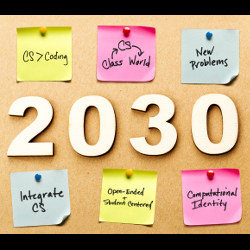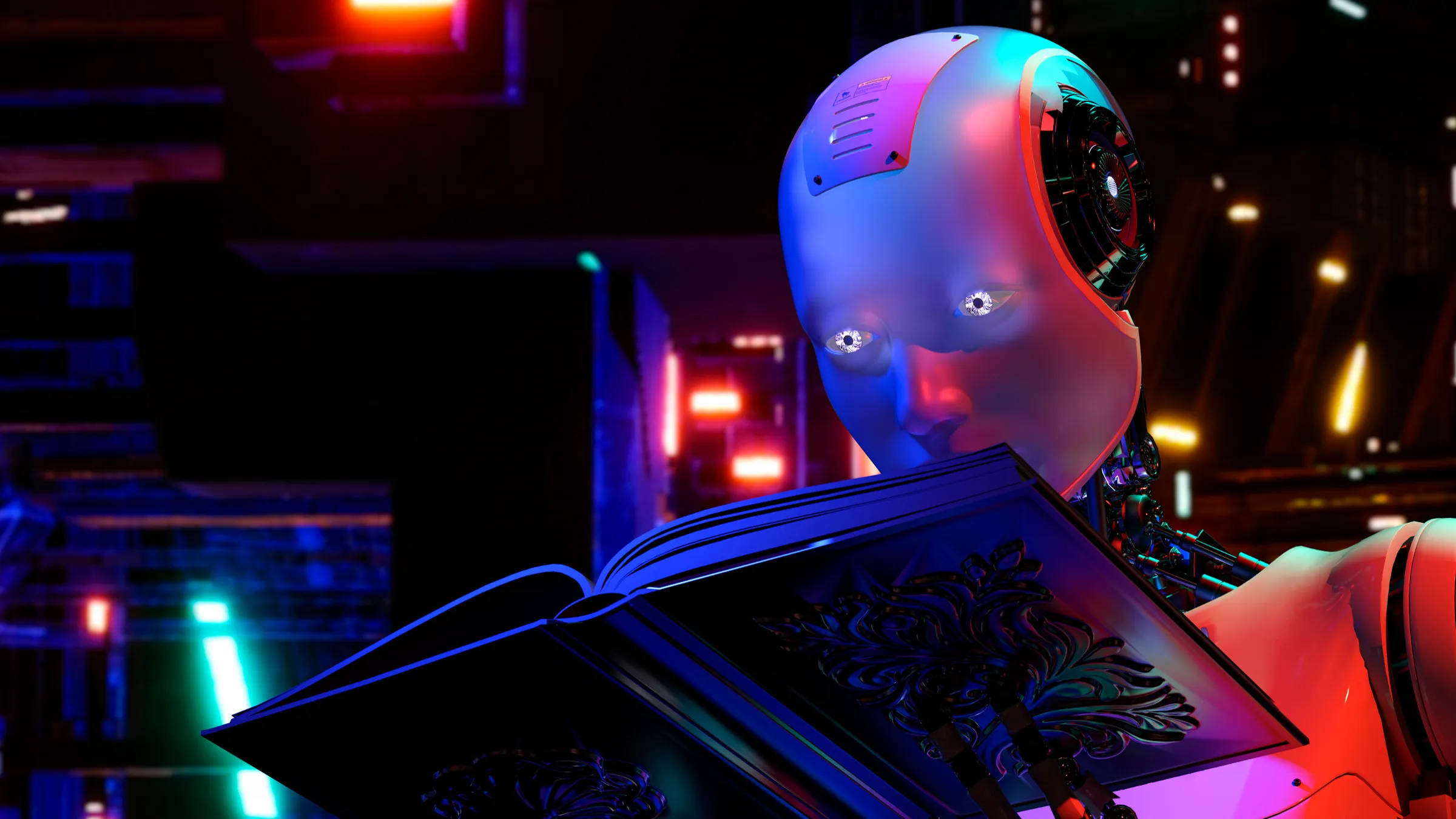
With the increased prevalence of U.S. states including computer science as a required subject in K-8 education (and as an elective in 9-12), in the next decade, nearly every child in the U.S. will be taking CS classes. The rapid integration of CS into the current education system has challenged states, districts, and teacher preparation programs to revamp their current efforts considerably. As this is a relatively new innovation and challenge, it provides us with a unique opportunity to consider our agenda: What is the goal of CS education? In the K—12 context, CS is often synonymous with coding—in fact, to many educators, CS is only coding. We suggest the goal of CS K—12 education should be for K—12 students to understand CS beyond simply learning to code. The students of the next decade will become the workers, creators, policymakers, and innovators of the 2040s and beyond. Preparing these future innovators requires a reframing of CS education that deeply considers what kinds of citizens we are trying to develop. For example, what are the ethical considerations around computer science and technology use? Addressing these questions requires curricula that is more student-, community-, and equity-centered.
Making CS matter for all students: CS needs to be more than just coding. While we agree that coding is a critical part of CS education, it cannot be the sole focus. Several large-scale studies have shown that a failure to connect CS education to the lives of students, particularly young women and underrepresented minorities, is causing them to abandon CS as a career path, as it is not something for "people like them."1 Knowing how to code is a critical factor in women and underrepresented students succeeding and persisting in post-secondary CS education.5 However, we need to ensure they have relevant experiences at the K—12 levels first. One key aspect to providing successful K—12 CS experiences is recognizing that the current one-size-fits-all CS curricula being implemented, often does not actually appeal to all students. The problems students want to address in rural Illinois are likely far different than their counterparts in Chicago, even though they are separated by only a few miles. By adapting CS curricula to empower students to meaningfully connect CS to their lives, we will be more likely to show them why learning CS can, and should, matter to them.
Moving CS from the classroom to the world. The past decade has seen remarkable change due to the advent of the smartphone, dramatically changing how we connect and relate to the world around us. Over the next decade, computing will radically change again. As most current kindergarteners are expected to graduate high school in 2032, how will computing change the world around them? How do we prepare them for careers and lives with technologies we can only partially anticipate? We need to prepare them to be agile, and CS can help us do that.
These technologies increasingly offer the potential to enable what students build and create in their classrooms to be directly connected to their lived lives (for example, through smartphones and the Internet of Thing (IoT). This in turn, allows students to see how CS operates in the world as a means to solve real-world problems. However, for students to see themselves as capable of creating these solutions, we need to develop educational initiatives that support students' development of their critical consciousness and computational identities—the idea that they are empowered citizens who can create help shape the world they live in, and why they should do so.4
Preparing students to solve new problems with CS. While newer ideas around CS like data science, artificial intelligence (AI), machine learning, deep learning, distributed and quantum computing are all at different levels of adoption, each will change what it means to apply computing to our daily lives. Many of these new applications will require less programming and more understanding of how to use them and their associated challenges.3
Few K—12 students will need to develop their own machine learning algorithms, but most will need to understand the critical issues around training and evaluating the algorithms, and bias and equity. For AI, students must tackle the already growing issues such as who would be held responsible for self-driving car accidents and how can historical biases affect models of future events? For the IoT, students will need to understand the importance of data privacy, sharing, and distributed systems that require critical understandings of the ecosystems that surround the code they write. For data science, students will need to understand how to collect and convert data in ways that can be useful to computer models and how to critically evaluate the results. Perhaps most important is preparing students to be able to recognize bias and identify ethical ways to use and integrate computers into their daily lives. By tackling these issues as part of a comprehensive CS curricula, we entrench CS as something that connects to the issues students increasingly face and empowers them to be engaged problem solvers.
We need to develop educational initiatives that support students' development of their critical consciousness and computational identities.
Using CS as an interdisciplinary tool. Over the next decade, we anticipate CS education will be integrated into a range of other disciplines (for example, physics, economics, civics, environmental sciences) rather than just a stand-alone subject. Integrating CS (not just computational thinking) into these subjects, offers the potential for making subjects more personally meaningful. Students can develop their own sensors to capture and report on environmental factors in their communities for science class, or design their own data models to visualize economic conditions at critical moments in history (for example, the great depression). We are only scratching the surface of researching the potential of these interdisciplinary approaches to CS. Successfully integrating CS into multiple domains will likely require individual subjects to develop introductory CS lessons specific to their domain that extend what they learn in their CS classes.
Framing computational literacy as a fundamental literacy. We believe K—12 students' understanding of the role of computing in non-computing disciplines will be critical for future work success. By advocating for a vision of CS that extends beyond just programming, we get closer to the vision of computing as a fundamental literacy that can be used by all. In their future jobs, it is unlikely that all students in the next decade will be programmers or data scientists. However, the ability to understand how computing (and by extension coding) can be applied to their jobs and lives enables them to be truly computationally literate. Managers, designers, and team members will need to understand what types of computing solutions are possible and "speak the language of programming" to be a part of effective work teams. A basic understanding of computing and computational thinking must be a foundational part of all students' education to prepare them to contribute solutions to the problems of their futures.
Challenges associated with student-centered CS. This vision of the next decade of CS education is not without significant challenges. We must develop new forms of formative and summative CS assessment that move beyond assessing students' ability to write and debug code, toward those that capture changes students' attitudes toward computing, their computational identities, their sense of digital empowerment, and their ability to engage in computational design thinking processes.4 While many researchers are already looking at this from a research perspective, these outcomes are equally important in teachers' classroom evaluations. Additionally, if CS education is truly student centered, how do we develop assessments that properly attend to the individual, is contextualized to their specific learning, and allows for the necessary variation that comes out of this kind of learning?
If we are serious about creating relevant K—12 CS curricula that provides students opportunities to connect to their lives and communities, we need to find ways for these communities to buy in to these initiatives. A failure to do so will reinforce ideas that computing designs at rather than for these communities. We urge the field to examine ways to use student- and human-centered pedagogical approaches that will enable students to select problems that are personally meaningful and use computing to help solve them.
We want to challenge those involved in CS education to create and use more open-ended, student-centered, and real-world K—12 CS curricula. This will require more intensive curriculum planning and increased teacher program development. Many states are implementing new CS teaching certification and licensure programs that focus primarily on programming and linear approaches to CS education. We are at a critical juncture in supporting the next decade of CS teachers. We must ensure these student-, community-, and ethics-focused pedagogies are deeply integrated into the licensure process, or risk duplicating the challenges faced by math and sciences, which has largely failed to show students how these disciplines apply to their lives and futures.2
We also must ensure there is recognition of the importance of these non-programming focused CS pedagogies throughout the K—12 pipeline. Superintendents, principals, policymakers, and parents all need to recognize the value in moving beyond a pure programming-focused approach to CS. A failure to get them to understand the importance of this approach will result in small pockets of innovation within a sea of traditional CS practices—the fate of many innovative learning initiatives.
We are often not placing enough attention on what the broader outcomes of CS should be, and what kind of citizens we are preparing the next decade of students to be.
Next steps in CS education. We are at a pivotal moment in the future of CS education. In the rush to implement large-scale CS education, we are often not placing enough attention on what the broader outcomes of CS should be, and what kind of citizens are we preparing the next decade of students to be. We need to look at how we prepare these students to not only succeed, but also thrive in a landscape in which they may not need to program, but will need to deeply understand how computing (and programming) can influence and shape their work and lives.
For a successful next decade, CS education needs us to immediately confront digital inequities, not only in access to technology, but in whose problems are being solved by that technology. If we create educational initiatives that reinforce existing power dynamics, we will lose out on the unique contexts, issues, and needs of underrepresented students. This will result in failed efforts to truly create CS for all. NCWIT's newest messaging platform conveys the importance of empowering every student: "The idea you don't have is the voice you haven't heard." With the broad sweeping changes to both K—12 CS curriculum and teacher training/licensures, we must ensure they incorporate digital equity and student-centered pedagogies to prepare all students to computationally solve the problems of their futures.



Join the Discussion (0)
Become a Member or Sign In to Post a Comment